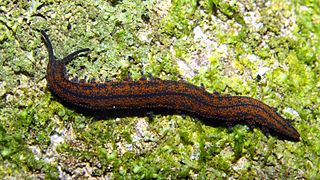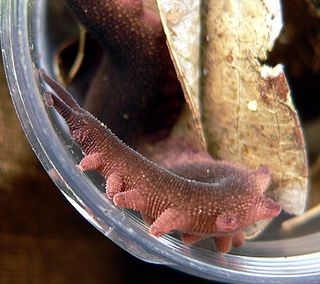
Peripatus is a genus of velvet worms in the Peripatidae family. The name "peripatus" is also used to refer to the Onychophora as a whole, although this group comprises many other genera besides Peripatus. The genus Peripatus is found in Central America, the Caribbean and northern South America. This genus is viviparous, with mothers supplying nourishment to their embryos through a placenta.
Macroperipatus is a genus of Neotropical velvet worms in the Peripatidae family. Velvet worms in this genus can have as few as 24 pairs of legs or as many as 42 leg pairs. This genus is viviparous, with mothers supplying nourishment to their embryos through a placenta.
Mesoperipatus is a monospecific genus of velvet worm in the Peripatidae family, containing a single species Mesoperipatus tholloni. It is found in Gabon, making it the only known species of velvet worm in the tropics of Africa, and the only known species of peripatid velvet worm in Africa. Females of this species have 24 to 27 pairs of legs; males have 23 or 24. This species is viviparous, but too little is known of its embryology to describe its reproductive mode in any more detail; the presence of a placenta, for example, has not been confirmed.
Opisthopatus is a genus of South African velvet worms in the family Peripatopsidae. Velvet worms in this genus are found in South Africa, in the Eastern Cape, KwaZulu-Natal, and Mpumalanga provinces, as well as in Lesotho and Eswatini. This genus was first proposed in 1899 by the zoologist William F. Purcell to contain the newly discovered species O. cinctipes, which he designated as the type species.

Peripatoides is a genus of velvet worms in the family Peripatopsidae. Velvet worms in this genus are found throughout New Zealand. Like all velvet worms, these animals are nocturnal predators that spit a sticky slime to trap their prey. Unlike the species in the only other genus of velvet worms found in New Zealand, Ooperipatellus, which lay eggs, the species in the genus Peripatoides are live-bearing (ovoviviparous).

Peripatopsis is a genus of velvet worms in the Peripatopsidae family. These velvet worms are found in the KwaZulu-Natal, Western Cape, and Eastern Cape provinces of South Africa. This genus was proposed by the British zoologist Reginald I. Pocock in 1894 with Peripatopsis capensis designated as the type species.
Plicatoperipatus is a monospecific genus of velvet worm containing the single species Plicatoperipatus jamaicensis. It is endemic to Jamaica. Females of this species can have as many as 43 pairs of legs, the maximum number found in the phylum Onychophora. In a large sample collected in 1988, however, females ranged from 35 to 39 leg pairs, with 37 as the mean and the most common number, and males ranged from 31 to 37 leg pairs, with 35 as the mean and the most common number. This species ranges from 25 mm to 65 mm in length. In the 1988 sample, the mean length for males was 33 mm, and the mean length for mature females was 51 mm. This species is viviparous, with mothers supplying nourishment to their embryos through a placenta.
Speleoperipatus is a monospecific genus of velvet worm in the Peripatidae family, containing the single species Speleoperipatus spelaeus. This species is a pale greenish yellow, almost white, with 22 or 23 pairs of legs and no eyes. Specimens range from 27 mm to 34 mm in length. The minimum number of leg pairs found in this species (22) is also the minimum number found in the neotropical Peripatidae. This velvet worm is viviparous, with mothers supplying nourishment to their embryos through a placenta.

Peripatopsidae is one of the two living velvet worm families. This family includes more than 140 described species distributed among 41 genera, but some authorities deem only 131 of these species to be valid. The French zoologist Eugène Louis Bouvier proposed this family in 1905 with Peripatopsis as the type genus.

Eoperipatus is a genus of velvet worms in the family Peripatidae. These velvet worms have been reported from locations throughout Southeast Asia, including Malaysia, Singapore, Thailand, and Vietnam. This genus exhibits lecithotrophic ovoviviparity; that is, mothers in this genus retain yolky eggs in their uteri.
Heteroperipatus is a genus of Central American velvet worms in the Peripatidae family. The number of legs in this genus varies within species as well as among species and ranges from 26 pairs to 32 pairs. This genus is viviparous, with mothers supplying nourishment to their embryos through a placenta.
Aethrikos is a monospecific genus of ovoviviparous velvet worm, containing the single species Aethrikos setosa. This species has 15 pairs of legs in both sexes. This species exhibits lecithotrophic ovoviviparity; that is, mothers in this species retain yolky eggs in their uteri. The type locality of this species is Styx River State Forest, New South Wales, Australia.

Occiperipatoides is a monospecific genus of velvet worm containing the single species Occiperipatoides gilesii. This genus is ovoviviparous and found in Western Australia. The genus is part of the ancient phylum Onychophora that contains soft-bodied, many-legged relatives of arthropods known commonly as velvet worms.
Cerradopatus is a monospecific genus of velvet worm containing the single species Cerradopatus sucuriuensis. Males of this species have 28 or 29 pairs of legs; females have 30 to 32. This species is native to the Brazilian savannah. This species is viviparous, with mothers supplying nourishment to their embryos through a placenta.
Principapillatus is a monospecific genus of velvet worm containing the single species Principapillatus hitoyensis. Males of this species have 26 to 29 pairs of legs, usually 27 or 28; females have 30 to 32, usually 30 or 31. This velvet worm is viviparous, with mothers supplying nourishment to their embryos through a placenta. This species was discovered in Costa Rica.
Metaperipatus is a genus of velvet worms in the family Peripatopsidae that contains two species found in Chile, including Metaperipatus inae. This genus was created by the American zoologist Austin Hobart Clark in 1913 to contain the type species, M. blainvillei. Authorities believe M. blainvillei is a species complex, however, and some consider M. blainvillei a nomen dubium.
Paropisthopatus is a monospecific genus of velvet worm containing the single species Paropisthopatus umbrinus. Females of this species range from 20 mm to 70 mm in length. The type locality is in central Chile. Velvet worms in this genus have 16 pairs of legs. This genus exhibits matrotrophic viviparity, that is, mothers in this genus retain eggs in their uteri and supply nourishment to their embryos, but without any placenta.
Paraperipatus is a genus of velvet worms in the family Peripatopsidae. This genus exhibits matrotrophic viviparity, that is, mothers in this genus retain eggs in their uteri and supply nourishment to their embryos, but without any placenta. Species in this genus are found in New Guinea and the surrounding islands, including the Maluku achipelago.
Opisthopatus cinctipes is a species of velvet worm in the Peripatopsidae family. This species has 16 pairs of legs, all with claws and all used for walking. The color of the dorsal surface varies from blue to olive green. Females range from 7 mm to 50 mm in length, whereas males range from 6 mm to 36 mm. Like other velvet worms in this genus, this species exhibits matrotrophic viviparity, that is, mothers in this genus retain eggs in their uteri and supply nourishment to their embryos, but without any placenta. The type locality is in South Africa.
Mongeperipatus is a genus of velvet worms in the family Peripatidae from Costa Rica. The biologists José Pablo Barquero-González, Steven Sánchez-Vargas, and Bernal Morera-Brenes introduced this genus in 2020 to contain the newly discovered type species, M. kekoldi, together with another species, M. solorzanoi. A phylogenetic analysis using DNA sequences placed these two species in their own monophyletic clade. Furthermore, these two species share morphological characters that indicate that these species do not belong in the other genera and instead belong together in a separate genus. The genus Mongeperipatus is named in honor of the Costa Rican biologist Julián Monge-Nájera.






